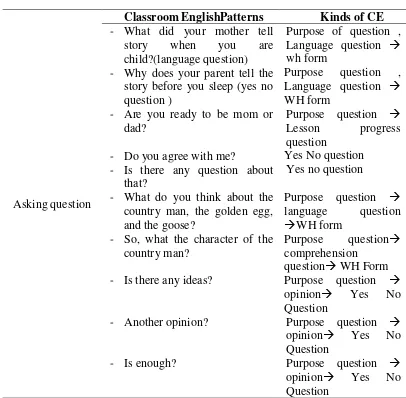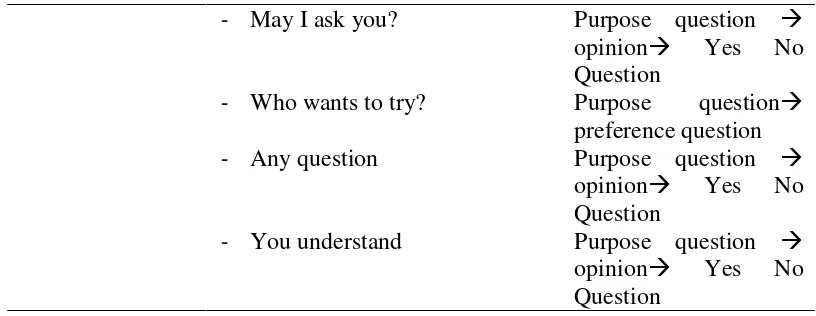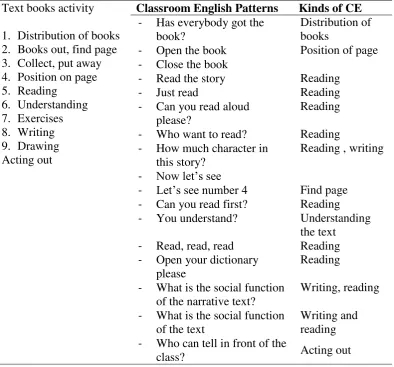33 Syntax Literate : Jurnal Ilmiah Indonesia – ISSN : 2541-0849 e-ISSN : 2548-1398
Vol. 2, No 1 Januari 2017
TEACHING PATERN USED BY THE ENGLISH TEACHERS IN TEACHING AND LEARNING PROCESS
Rika Septiani
Universitas Islam Al Ihya
Email : [email protected] Abstrak
The research was carried out at SMA Negeri 1 and SMA Negeri 3 Kuningan from August 2014 to October 2014by using qualitative method in observational design. The respondents of this research were the English teachers of grade XII. The data analysis applied the descriptive data. The data were taken from the observation and interview. The observation held in the activity of the teaching and learning process, and the interview done to the English teachers after teaching and learning process. Descriptive analysis was applied to analyze by underlying words, word phrase and sentences, sharpening the early focus by continued observation and/or in depth interview The result of this research is the English teachers used the pattern of classroom English with several aspects; get thing done in the classroom, asking questions, beginning of lesson, end of lesson, textbook activity, games and songs, repetition and response, encouragement and confirmation, set phrase, text book activity, blackboard activity, repetition and response, progress in work. The aspect of asking question was the most patterns used by the English teachers in teaching and learning process. The main reason that the English teachers more use asking and question in the teaching and learning process were they want to stimulate the students to be an active one and to rich the effective of classroom teaching and learning activity.
Key word:Teaching Patterns, English Teachers, Teaching and Learning Process
Introduction
In Indonesia English is one of the compulsory subject which is taught in elementary school, junior high school, senior high school and university as the first foreign language. In other words, learning English is needed in Indonesia. Therefore, English is an essential subject to be learned at school in Indonesia. Learning foreign language is not easy, so that the role of English teacher is an important in English teaching learning process.
Rika Septiani
34 Syntax Literate, Vol. 2, No. 1 Januari 2017 from internal and external factors which have played some significant roles that influence the learning process; such as first is the target language group, including the learner’s language aptitude, the intelligence and the motivation. The next is the learning environment, encompassing the instructor, the learning materials and the attitude of learner towards the target language. Many cases turn up that the English teachers is neglect the use of classroom English in explaining the materials, in the fact teachers have to be able to interact with English in the classroom.
Classroom English plays an important role in the English teaching and learning process especially for the non native teachers. As Hughes and Moate (2007: i) explain practical classroom English is basically a comprehensive list of classroom phrases that he/she will need when running a lesson in the English. It also has extensive exercise and activities to help you practice and use the phrases. It is intended for non-native teachers of English who work with teenager and young adult in formal education. The mastery of classroom English is one of the teacher’s requirement competencies. It is an important aspect for teaching both productive and receptive skills. In English teaching and learning process is necessary to use English in the interaction of the teacher in explaining the material. In the English classroom interaction the teacher’s explanation on the material is mostly performed in English. In the other hand, the all activity in English classroom are mostly verbally done in English.
The aim of using classroom English in the classroom during the teaching and learning process is to provide the learners to get the authentic language experience. Hughes and Moate (2007: i) states that the benefits from using classroom English are: 1) to encourage non native teacher to use more English in the day to day running of the English classes, 2) to extend the range of classroom situations and learning activities that the teacher feel confident and competent to handle in English, 3) to make the teacher think more deeply about the role of their English in the classroom, 4) to inspire the teacher with ideas for making the classroom a more dynamic and authentic environment for the students to practice their English, and 5) to develop the teacher language skills in two important areas of teaching: instruction giving and question asking
Teaching Patern Used By The English Teachers
Syntax Literate, Vol. 2, No. 1 Januari 2017 : 33-41 35 Findings And Result
1. Pattern / Utterance Used By The English Teachers in Kuningan
Get things done in the classroom, was found the pattern of commanding, persuading, and requesting
Table 1 The Finding in Get Thing Done in the Classroom Get thing done in
classroom 1. commanding 2. requesting
3.sugesting and persuading
Classroom English
Patterns
Kinds of CE
- Open your dictionary ! - close your book !
Commanding - follow me please Requesting
Don’t forget to study Persuading and suggesting
2. Asking Question.
Table 2 Asking Question Aspect
Asking question
Classroom EnglishPatterns Kinds of CE
- What did your mother tell story when you are child?(language question)
Purpose of question , Language question wh form
- Why does your parent tell the story before you sleep (yes no question )
Purpose question , Language question WH form
- Are you ready to be mom or dad?
Purpose question Lesson progress question
- Do you agree with me? Yes No question - Is there any question about
that?
Yes no question - What do you think about the
country man, the golden egg, and the goose?
Purpose question language question
WH form - So, what the character of the
country man?
Purpose question comprehension
question WH Form - Is there any ideas? Purpose question
opinion Yes No Question
- Another opinion? Purpose question opinion Yes No Question
- Is enough? - Purpose question
Rika Septiani
36 Syntax Literate, Vol. 2, No. 1 Januari 2017 - May I ask you? - Purpose question
opinion Yes No Question
- Who wants to try? - Purpose question preference question - Any question - Purpose question
opinion Yes No Question
- You understand Purpose question
opinion Yes No Question
3. Beginning of the lesson
Table 3 Beginning of the Lesson
Beginning of the lesson 1.In the corridor 2.Greetings
3.Transition to work 4.Absence
5.Lateness
Classroom English
Patterns
Kinds of CE
- Good morning Greeting
- Please pray Transition to work - How is life? Greeting
- Who is absent today?
Checking absence
4. End of Lesson
Table 4 End of lesson
End of the lesson
Classroom English Pattern Kinds of CE
- Ok please keep study - Thank you for your
attention, see you
Stop working - Please read the next page in
the home,
Setting homework
- See you Stop working
5. Set Phrase
Table 5 Set phrase
Set phrase
Classroom English Pattern Kinds
Teaching Patern Used By The English Teachers
Syntax Literate, Vol. 2, No. 1 Januari 2017 : 33-41 37 6. Text Book Activity
Table 6 Classroom English about text book activity
Text books activity 1. Distribution of books 2. Books out, find page 3. Collect, put away 4. Position on page 5. Reading 6. Understanding 7. Exercises 8. Writing 9. Drawing Acting out
Classroom English Patterns Kinds of CE
- Has everybody got the book?
Distribution of books
- Open the book Position of page - Close the book -
- Read the story Reading
- Just read Reading
- Can you read aloud please?
Reading - Who want to read? Reading - How much character in
this story? - Now let’s see
Reading , writing
- Let’s see number 4 Find page - Can you read first? Reading - You understand? Understanding
the text - Read, read, read - Reading - Open your dictionary
please
Reading - What is the social function
of the narrative text?
Writing, reading - What is the social function
of the text
Writing and reading - Who can tell in front of the
class? Acting out
7. Blackboard Activity
Table 7 Blackboard Activity
Blackboard activity 1. Come out, write 2. Attention, read,
clean
Classroom EnglishPattern Kinds of CE
- Can you write in the white board please?
Clean the blackboard - Please write on the
blackboard
Write, come out 8. Repetition and Response
Table 8 Repetitionand Response
Repetition and responses 1. repeat, louder 2. grouping
3. cycles, not catching
Classroom English
Patterns
Kinds of CE
- Follow me please Repeat - Would you like to speak
louder?
Rika Septiani
38 Syntax Literate, Vol. 2, No. 1 Januari 2017
- Speak Speak
- Listen to me and repeat Repeat
- Speak up Speak louder
- Can you repeat Repeat - Ok together, 1..2..3 Repeat
9. Encouragement and Confirmation
Table 9 Encouragement and Confirmation
Encouragement and confirmation
1. confirmation 2. encouragement 3. crumbling
Classroom English
Patterns
Kinds of CE
- Good Encouragement
- Thank you Confirmation
- The beautiful flower like your face
Encouragement
- Next Encouragement
- That’s it Encouragement
- Ok good Encouragement
- Give applause Encouragement - Thank you , good Encouragement
- Next Encouragement
- Ok good Encouragement
- Yes thank you Encouragement
10.Progress in Work
Table 10 Progresses in work
Progress in work 1. able to participate 2. readiness
3. choices 4. transitions 5. explaining,
outlining
Classroom EnglishPatterns
Kinds of CE
- What do you think about...?
Outlining
- Is there anyone here? Able to participate
- Ok Readiness
- Good Able to
participate
- lets gone Readiness
- why you must understand the kinds of the text
Outlining - what is the orientation of
the text
Explaining
Teaching Patern Used By The English Teachers
Syntax Literate, Vol. 2, No. 1 Januari 2017 : 33-41 39 Table 11 Dominant pattern of classroom English
Get thing done in the classroom 3
Asking question 21
Beginning of the lesson 4
Text book activity 16
Blackboard activity 2
Repetition and response 11
End of the lesson 4
Set phrase 1
Progress in work 8
Encouragement and confirmation 11
Asking question was becomes the dominant pattern used by the English teachers in teaching and learning process, which are 21kinds of phrase of question. The pattern of question used by teachers was WH Form, yes no question, preference question. The teachers used the direct question to the students.
The text book activity become the second rank of the pattern used by elnglish teacher in the teaching and learning process. text book activity is the main process in the teaching and learning process in the classroom. Teachers transferred the materials use text book. The materials was about genre, it mean needed text book in teaching and learning process. the process of teaching and learning in the classroom was active classroom, teacher asked student be an active students when the process, by dividing them group discussion in the classroom, after that teacher asked them to present what they get in the book, in front of the class.
Conclusion
Rika Septiani
40 Syntax Literate, Vol. 2, No. 1 Januari 2017 BIBLIOGRAFI
Ball, Loewenberg Deborah and Forzani M. Francesca. 2009. The Work of Teaching and the Challenge for Teacher Education. American Association of Colleges for Teacher Education (AACTE): Sage Publication. Retrieved from http://www.sagepublications.com. DOI: 10.1177/0022487109348479. Accessed on May 9, 2014 at 1:05 PM
Brown, H. Douglas. 2007. Teaching by Principles ; An Interactive Approach to Language Pedagogy 3rd edition. New York: Pearson Longman.
_______. 2000. Teaching by Principles: An Interactive Approach to Language Pedagogy. New York: routledge
Depdiknas RI [Departemen Pendidikan Nasional Republik Indonesia]. 2006. Pedoman Kurikulum Tingkat Satuan Pendidikan untuk Sekolah Menengah Atas Tahun 2006. Jakarta: Depdiknas RI
Elizabeth, M.E.S and Digumarti Bhaskara Rao. 2007. Methods of Teaching English. New Delhi: discovery publishing house.
Fox, Dennis. 1983. Personal Theories of Teaching. A Paper.Retrieved from http://www.iei.liu.se/pie/proviking/kursmaterial/1.180648/2fox.pdf.accessed at May 9, 2014 on 12:11 PM
Gebhard, G. Henry. 2009. Teaching English as a Foreign or Second Language 2nd Edition. United States: University of Michigan Press.
Harmer, Jeremy. 2007. How to Teach English. England: Longman.
Heinich, Robert, et al. 1996. Instructional Media and Technologies for Learning 5th Edition.United State. Prentice Hall
Hughes, Glyn, Josephine Moate, Tina Raatikainen. 2007. Practical Classroom English. Oxford: Oxford University Press.
_______. 1981. A Handbook ofClassroom English. Oxford: Oxford University Press Mattarim, Karim and Abdul Rahim Hamdan. 2011. The Teaching Constraints OF
English as a Foreign Language in Indonesia: The Context of School Based Curriculum.Retrived from http://www.sosiohumanika-jpssk.com/sh_files/File/Karim.pdf . Accessed on May 10, 2014, at 11:32 AM Lauder, Allan.2008. The Status and Function of English in Indonesia: A Review of Key
Teaching Patern Used By The English Teachers
Syntax Literate, Vol. 2, No. 1 Januari 2017 : 33-41 41 http://journal.ui.ac.id/index.php/humanities/article/viewFile/128/124. accessed on May 10,2014 at 6:33 am
Noddings, Nel. 2003. Is Teaching a Practice? .The Journal of the Philosophy of Education Society of Great Britain. UK. Retrieved from http://exordio.qfb.umich.mx/archivos%20pdf%20de%20trabajo%20umsnh/aphilo sofia/educaci%C3%B3n%20filosofia/libro%20dos/Is%20Teaching%20a%20Pract ice.pdf .accessed May 9, 2014 at 1:16 PM
Nunan, D. 1991. Language Teaching Methodology.A Textbook for Teachers. Norwich: Prentice Hall
Petkova, Mariana M. 2009. Classroom Discourse and Teacher Talk Influences on English Language Learner students' Mathematics Experiences. Graduate Theses and Dissertations.http://scholarcommons.usf.edu/etd/2142 . accessed on January 19th 2014 at 10:28 am
Pritchard, Alan. 2009. Ways Of Learning; Learning Theories and Learning Styles in the Classroom 2nd Edition. London and New York: Routledge.
Ramelan. 1992. Introduction to Linguistics Analysis. Semarang: IKIP Semarang Press. Richard, J.C. 2008.Teaching Listening and Speaking;From Theory to Practice. New
York: Cambridge University Press.
Shamsipour, Anahita and Allami ,Hamid. 2012. Teacher Talk and Learner Involvement in EFL Classroom: The Case of Iranian Setting ISSN 1799-2591. Theory and Practice in Language Studies, Vol. 2, No. 11, pp. 2262-2268, November 2012. ©
2012 ACADEMY PUBLISHER Manufactured in
Finland.doi:10.4304/tpls.2.11.2262-2268
Sugiyono. 2010. Metode Penelitian; Pendekatan Kuantitatif, Kualitatif, Dan R&D. Bandung: Alfabeta.
UNESCO.2010. Secondary Education Regional Information Base: Country Profile Indonesia. Thailand: UNESCO Asia and Pacific Regional Bureau for Education.
Zheng , Mingzhi and Zhou1, Yaping. 2014, Influence of English Teachers’ Classroom
English on Students’ Learning Enthusiasm in Junior High School .International



